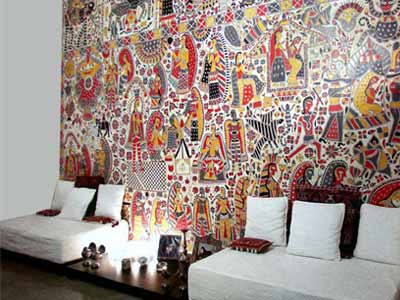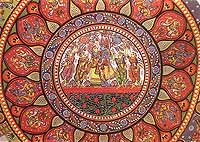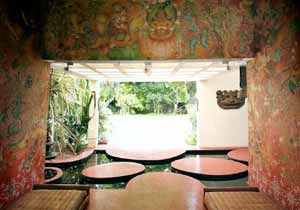|
A thing of beauty is a joy for ever:
Its loveliness increases;
It will never pass into nothingness.
— John Keats 
There is an 'art' to it
So everything seems in place for your newly done up home. But something's missing and you can't put your finger on it. So you take a look around again, slowly, and notice those bare boring walls. What can you do with a plain wall? For starters, you could hang a piece of art. An artwork is an easy solution for unadorned walls. That single touch can transform the entire look and feel of a room. Archana Rao of DSP Design Associates says, "Every space has a standard, such as light fixtures, furniture etc. To bring in colour and warmth and to bring a room together, an artwork provides the ideal focal point and enlivens the place". Buy right
 Browsing and buying art is an involving activity and should be enjoyed thoroughly. You don't need bravura or an in-depth knowledge of art for you to choose it for your space. But it does help to know a few parameters on what to look out for, and what is best avoided. Browsing and buying art is an involving activity and should be enjoyed thoroughly. You don't need bravura or an in-depth knowledge of art for you to choose it for your space. But it does help to know a few parameters on what to look out for, and what is best avoided. You can choose any kind of painting, tapestry, murals and fresco and even wall clocks. It brightens, embellishes and enhances the wall space, and brings in positivism to any room. Selecting a piece of art is very individualistic and it depends on what that space reads for the person. Archana suggests a visit to art galleries for a feel of this medium of expression. She feels that there are three basic criteria you need to look at while buying artwork in terms of value to décor: - How you relate to it. The piece of art should mean something to you, and bring you a sense of joy and satisfaction each time you look at it,
- Where will it fit in, which wall will you choose to highlight and is there enough and more light to enhance this pièce de résistance and,
- It must have a definitive theme.
Along with these criteria, the other standards for selecting and hanging artwork are equally important.  Theme: It is essential to look within the room space for a theme, and enforce it with artwork. If the artwork cannot justify itself with the theme, then it may turn out to be a waste of art space. Archana relates one such instance where a typical south Indian restaurant showcased Rajasthani murals. Considering themes to be sacrosanct, she was aghast at what it was doing to the décor. "It would have looked far more alluring with a combination of decorative mirrors with stained glass", she bemoans. What could work for homes, though, is a picture of assorted fruits in a bowl for a dining room, a print of Vincent Van Gogh's Starry Night for a blue-themed room, Tanjore paintings for a traditionally done up room with earthy colours, a bunch of photographs or a group of plain pencil lines or sketches all framed alike etc. Theme: It is essential to look within the room space for a theme, and enforce it with artwork. If the artwork cannot justify itself with the theme, then it may turn out to be a waste of art space. Archana relates one such instance where a typical south Indian restaurant showcased Rajasthani murals. Considering themes to be sacrosanct, she was aghast at what it was doing to the décor. "It would have looked far more alluring with a combination of decorative mirrors with stained glass", she bemoans. What could work for homes, though, is a picture of assorted fruits in a bowl for a dining room, a print of Vincent Van Gogh's Starry Night for a blue-themed room, Tanjore paintings for a traditionally done up room with earthy colours, a bunch of photographs or a group of plain pencil lines or sketches all framed alike etc.
Colour: Colours are subjective. They either accentuate a wall space or play it down. If you have a pastel-shade background, you can bring in colour to make it more vibrant and exciting, but if you have earthy colours, then subtle shades will tone it down and make it more calming. Contrasting colours will have more of an impact. Size: The depth of a room determines the size of an artwork. If the wall is big, then a single large painting works better than a small one which will seem tiny compared to the wall. Similarly, for narrow spaces, smaller paintings work better instead than large pieces which tend to dwarf the entire room. When hanging a picture over a piece of furniture such as a sofa for instance, centre it between the ceiling and the headboard of the sofa to make it seem proportionate. Also ensure that the art piece is not bigger than the sofa itself. Frame: Compose the artwork on the wall with the same kind of frame to unify and balance the pictures, whether they're two in number or twenty-two. Lines: Lines play an important role in visually tricking the eye to believe there is depth and dimensions where none exists. If there is a long aisle, pictures can be hung horizontally on the long wall. The continuity of these pictures break down the length of the corridor and make it seem smaller. Strong horizontal lines in a painting can make the room seem wider too. However, strong vertical lines in an artwork give an illusion of making low-ceilings seem higher. Once you have identified each of these standards in relation with your space, it may now become easier to select an art of your choice that will not clash with the accessories and furniture, but rather complements it gracefully. Painting: There is a mind-boggling variety of wall art to choose from, indulging every kind of taste and every conceivable budget. The most expensive are original paintings which also offer a tremendous scope for investment. An fairly new artist may charge anywhere between Rs 2000 to Rs 15,000 and a well-known artist may quote Rs1 lakh to Rs25 lakh upwards. If you're budget is not too high, but would still like something catered to your personal taste, then you could commission a local art student from an art institute such as Chitrakala Parishath, or if you cannot afford an original of your favourite masters (which could run in millions), then you could ask a galley like Streisand Art to reproduce the painting for you in oil. Another exclusive idea could be to immortalise a special occasion, like a wedding, or a portrait in a painting. These customised oil paintings are also a fabulous gift idea. The artist could take around six to seven weeks to deliver the reproductions or portraits, depending on the size, and the cost could vary accordingly. Another upcoming gallery, art-a-shastra, showcases works of G Subramanian, Ramesh Gorjala and Om Swami and the gallery provides an end-to-end service, from packaging to delivery at your doorstep with just one phone call (Anirudh Goutham - 09845038246). They also provide a platform to new artists to showcase their talent and can customise art to suit every kind of budget and requirement. Tapestry: Another way to add a colourful unique flavour to your wall is through a richly detailed tapestry. With a riot of colours depicting various scenes from medieval to traditional and contemporary, tapestries can fit into any colour scheme of a room with spirit. Some of the popular picture themes have Eastern and Oriental accents; nature which could be landscapes, animals, flowers, scenery etc.; religious tapestries which have pictures of angels, gods, the holy grail etc.; classics such as medieval, renaissance, historical and bayeux; modern tapestries which include modern art, abstract art, William Morris, etc., and romance and myths. Popular Indian tapestries include zari work, patchwork embroidery with sequins and beads from Gujarat and Orissa and batik work. They also come in different sizes, making a perfect fit to the wall of your room and are available in different materials from cotton, jacquard, hand-woven silk, wool and chenille. Tapestries have been very successful partly because of their portability. The costs vary roughly from Rs1200 to Rs16,000. Indian traditional tapestries can be found at any ongoing handicraft exhibition while other kinds of tapestries can easily be found online. Murals: Murals are an increasingly popular décor item to make an effective statement. Various materials can be used, such as metal, terracotta and acrylic paints among others, to express and communicate a thought. Murals can be made in a variety of sizes and designs, and can be bought ready-made or by commissioning an artist to create one according to the specifications in terms of size, materials and theme. Murals can be a cacophony of colours or a subtle blend of earthy shades depending on what works for your décor. Radhika Neelakantan, a mural artist based in Bangalore says that a mural works best when showcased in an area with ample light and where it is mostly likely to be seen, as, "you would want people to sit up and take notice of this wonderful medium of expression". A living room wall, patio or a landing could be ideal places for mural, apart from your home exterior walls. Predominantly Indian traditional wall décor: Cheriyal scrolls from Andhra Pradesh which depict stories from the Puranas and Hindu legends, were used as a visual aid by storytellers. This five-century old art uses earthy colours that are naturally derived which will not fade for more than a century. Madhubani paintings from Bihar are characterised by black lines filled with vibrant and contrasting colours, which are derived naturally, and are pictorial depictions of Durga, Radha and Krishna, Lakshmi, Ganesha and Shiva. Originally painted on walls and floors plastered with mud and dung, this art moved onto more commercial mediums such as paper. The painting's vivid and bold forms give the image of the characters a life of its own and enlivens any space, whether used as a mural or as a wall hanging. Patachitra or scroll paintings are another form of beautiful art which is remarkable in its jewel-like colour usage. These scroll paintings tell a story from Indian mythology and the scenes come to life in brilliant colours. This traditional folk-art from Bengal make a great collectors item. The other forms of splendid traditional art comprises of Warli art (Rs450), Kalamkari (Rs500), Tanjore (Rs1,100), Phad paintings and batik art. These works are easily available through art and handicraft exhibitions organised by the local state tourism and culture departments. They adorn any wall with elegance and some cost as little as Rs150, depending on the size. "African or Indian tribal masks (starting from Rs900), miniature paintings, brass wall-mountable Bastar figures in bell metal and wrought iron, hand crafted through the vanishing wax technique from artisans of Chattisgarh (Rs550 onwards), gem stone paintings (Rs700), decorative carved wooden Jharokhas from Rajasthan (Rs600) and hand crafted leather wall hanging made of embossed painted leather (Rs800 onwards) are also a great way to highlight a wall", says Karthik Ramanujam of art-a-shastra.
|